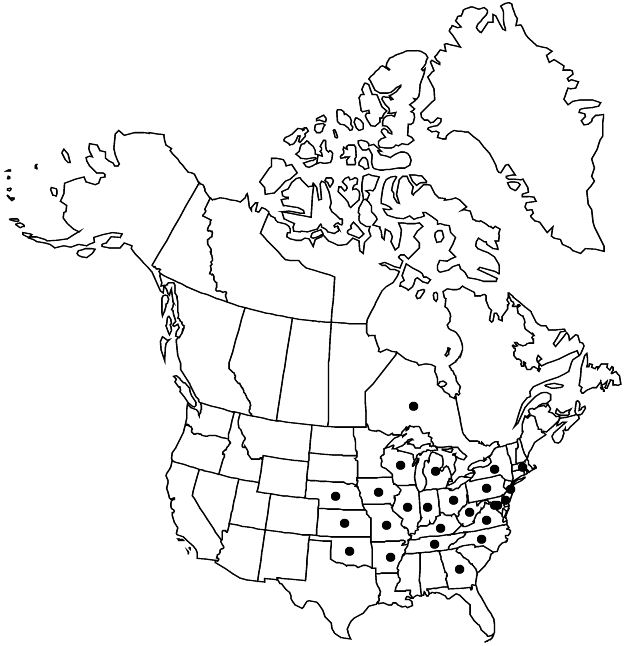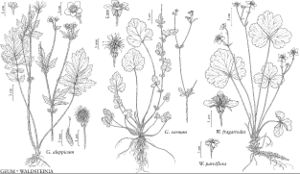Difference between revisions of "Geum vernum"
Fl. N. Amer. 1: 422. 1840.
FNA>Volume Importer |
imported>Volume Importer |
||
| (5 intermediate revisions by 2 users not shown) | |||
| Line 13: | Line 13: | ||
}}{{Treatment/ID/Special_status | }}{{Treatment/ID/Special_status | ||
|code=F | |code=F | ||
| − | |label= | + | |label=Illustrated |
}} | }} | ||
| − | |basionyms={{Treatment/ID/ | + | |basionyms={{Treatment/ID/Basionym |
|name=Stylypus vernus | |name=Stylypus vernus | ||
|authority=Rafinesque | |authority=Rafinesque | ||
| + | |rank=species | ||
| + | |publication_title=Neogenyton, | ||
| + | |publication_place=3. 1825 | ||
}} | }} | ||
|synonyms= | |synonyms= | ||
| Line 43: | Line 46: | ||
-->{{#Taxon: | -->{{#Taxon: | ||
name=Geum vernum | name=Geum vernum | ||
| − | |||
|authority=(Rafinesque) Torrey & A. Gray | |authority=(Rafinesque) Torrey & A. Gray | ||
|rank=species | |rank=species | ||
| Line 57: | Line 59: | ||
|publication title=Fl. N. Amer. | |publication title=Fl. N. Amer. | ||
|publication year=1840 | |publication year=1840 | ||
| − | |special status=Endemic; | + | |special status=Endemic;Illustrated |
| − | |source xml=https:// | + | |source xml=https://bitbucket.org/aafc-mbb/fna-data-curation/src/2e0870ddd59836b60bcf96646a41e87ea5a5943a/coarse_grained_fna_xml/V9/V9_103.xml |
|subfamily=Rosaceae subfam. Rosoideae | |subfamily=Rosaceae subfam. Rosoideae | ||
|tribe=Rosaceae tribe Colurieae | |tribe=Rosaceae tribe Colurieae | ||
Latest revision as of 23:53, 5 November 2020
Plants leafy-stemmed. Stems 20–70 cm, pilose or sparsely pilose, hairs septate. Leaves: basal 4–27 cm, blade simple or pinnate, leaflets 3–11, terminal leaflet larger; cauline 2–7 cm, stipules ± free, 8–25 × 7–12 mm, blade pinnate to 3-foliolate. Inflorescences 3–13-flowered. Pedicels glandular-downy, becoming glabrate in fruit. Flowers erect; epicalyx bractlets absent; hypanthium green; sepals reflexed, 1–3 mm; petals spreading, yellow to cream, oblong to elliptic, sometimes obovate, 1–2 mm, equal to or shorter than sepals, apex rounded. Fruiting tori on 3–7 mm stipes, glabrous. Fruiting styles geniculate-jointed, proximal segment persistent, 1.5–3 mm, apex hooked, nearly glabrous except for few septate-glandular hairs, distal segment deciduous, 0.7–1 mm, nearly glabrous except for short hairs. 2n = 42.
Phenology: Flowering spring.
Habitat: Moist woods, disturbed moist areas, flood plains, openings
Elevation: 0–600 m
Distribution

Ont., Ark., Del., D.C., Ga., Ill., Ind., Iowa, Kans., Ky., Md., Mass., Mich., Mo., Nebr., N.J., N.Y., N.C., Ohio, Okla., Pa., Tenn., Va., W.Va., Wis.
Discussion
Geum vernum is distinctive and is recognized by its early flowering, minute petals, lack of epicalyx bractlets, and heads of achenes soon elevated well beyond the recurved hypanthia and sepals. Recently, it has been expanding its range northward and has been collected with increasing frequency in southern Ontario, Massachusetts, Michigan, New York, and Wisconsin. No specimens could be located to confirm reports of G. vernum from Mississippi or Texas.
Selected References
None.
